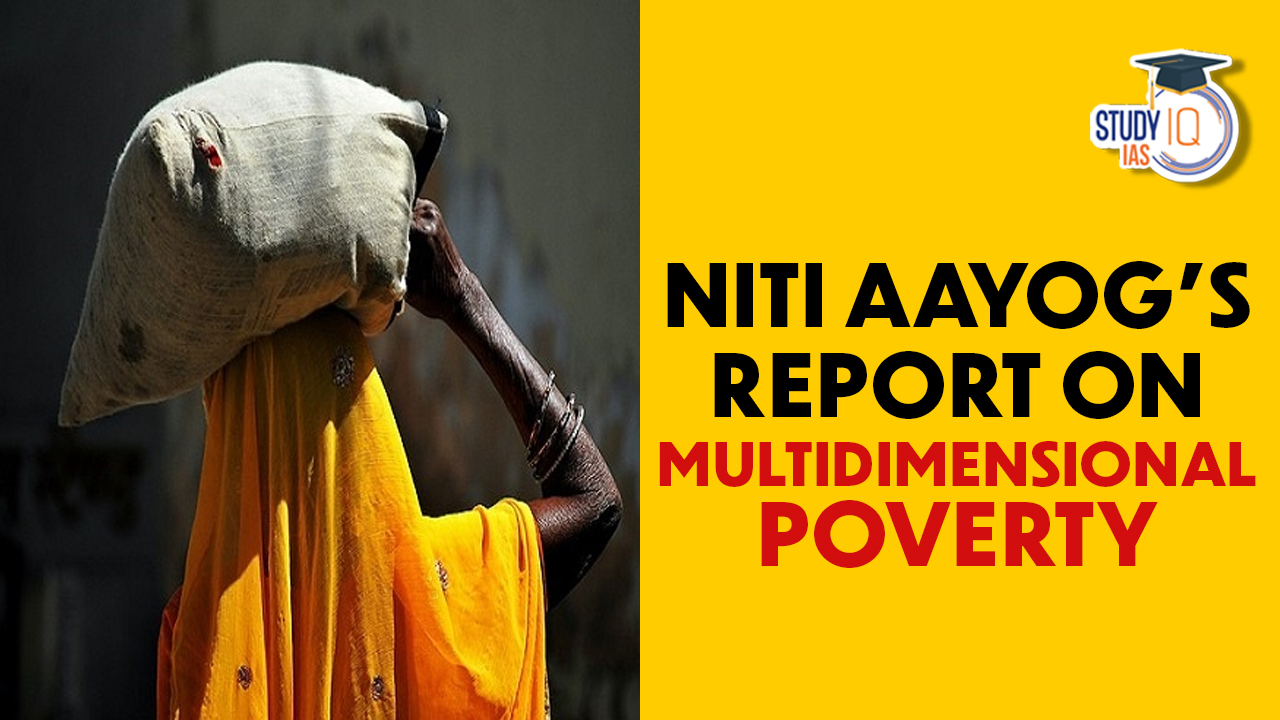Table of Contents
Context: India has registered a significant decline in the number of multidimensionally poor, according to the ‘National Multidimensional Poverty Index 2023’, released by the NITI Aayog.
About the ‘National Multidimensional Poverty Index (MPI) 2023’
- The National MPI 2023 presents the second edition of the national MPI and is a follow-up to the Baseline Report published in November 2021.
- It provides multidimensional poverty estimates for India’s 36 States & Union Territories, along with 707 administrative districts across 12 indicators.
- These estimates have been computed using data from the 5th round of the NFHS (NFHS-5) conducted in 2019-21.
- This edition also presents the changes in multidimensional poverty between the survey periods of NFHS-4 (2015-16) and NFHS-5 (2019-21).

- Methodology: Like the global MPI, India’s national MPI has three equally weighted dimensions – Health, Education, and Standard of living – which are represented by 12 indicators.
- The global MPI Report is jointly published by the Oxford Poverty and Human Development Initiative (OPHI) and the United Nations Development Programme (UNDP).
- Aggregation of the Index: The indices of the national MPI comprise:
- Headcount ratio (H): It is the proportion of multidimensionally poor in the population, which is arrived at by dividing number of multidimensionally poor persons by total population.
- Intensity of poverty (A): It is the average proportion of deprivations which is experienced by multidimensionally poor individuals. To compute intensity, the weighted deprivation scores of all poor people are summed and then divided by the total number of poor people.
- Final calculation of MPI: MPI value is arrived at by multiplying the headcount ratio (H) and the intensity of poverty (A), reflecting both the share of people in poverty and the degree to which they are deprived.
Key highlights of the National Multidimensional Poverty Index (MPI) 2023
- Steep Decline in Poverty: India has registered a significant decline of 9.89 percentage points in the number of multidimensionally poor, from 24.85% in 2015-16 to 14.96% in 2019-2021.
- The report claims that about 13.5 crore people came out of multidimensional poverty during the period from 2015-16 to 2019-21.
- According to the report, between 2015-16 and 2019-21, the MPI value has nearly halved from 0.117 to 0.066 and the intensity of poverty has reduced from 47% to 44%.
- It is a major contribution towards achieving SDG target 1.2 that aims to reduce “at least by half the proportion of men, women and children of all ages living in poverty in all its dimensions according to national definitions”. This indicates that India is well on course to achieve the SDG target 1.2 much ahead of 2030.
- State/UT-Wise Performance:
- Delhi, Kerala, Goa and Tamil Nadu have the least number of people facing multidimensional poverty along with the Union Territories.
- Bihar, Jharkhand, Meghalaya, Uttar Pradesh and Madhya Pradesh top the chart where the percentage of total population who are multidimensionally poor is high.
- Uttar Pradesh registered the largest decline in number of poor with 3.43 crore people escaping multidimensional poverty.
- Bihar saw the fastest reduction in MPI value in absolute terms with the proportion of multidimensional poor reducing from 51.89% to 33.76% in 2019-21.

- Rural-Urban Disparity: The report said rural areas witnessed the fastest decline in poverty from 32.59% to 19.28%, primarily due to decrease in the number of multidimensionally poor in States such as Bihar, Uttar Pradesh, Madhya Pradesh, Odisha, and Rajasthan.
- Multidimensional poverty in urban areas, during the same period, saw a decrease from 8.65% to 5.27%.



 List of Governor of States in India, Con...
List of Governor of States in India, Con...
 Daily Quiz 15 July 2025
Daily Quiz 15 July 2025
 Maratha Military Landscapes of India Add...
Maratha Military Landscapes of India Add...





















